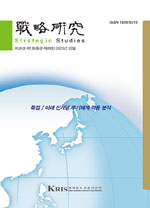- 영문명
- A History of North Korea's Military Strategy:From a Trojan Horse to Russian Roulette?
- 발행기관
- 한국전략문제연구소
- 저자명
- 강성학
- 간행물 정보
- 『전략연구』통권 제11호, 6~60쪽, 전체 55쪽
- 주제분류
- 사회과학 > 정치외교학
- 파일형태
- 발행일자
- 1997.11.30
9,400원
구매일시로부터 72시간 이내에 다운로드 가능합니다.
이 학술논문 정보는 (주)교보문고와 각 발행기관 사이에 저작물 이용 계약이 체결된 것으로, 교보문고를 통해 제공되고 있습니다.

국문 초록
영문 초록
Kim Ⅱ Sung's political regime in North Korea was. in a manner of speaking. a “son”of Stalin's Soviet Union. As a result, it goes without saying that the North Korean regime's interest was the same as that of the Soviet Empire. As demonstrated during the Korean War. North Korea's military strategy was a kind of “gift” from Stalin. whose own military strategy had been based on the strategic thought of Carl von Clausewitz, reformulated from personal experience during the Russian civil war. and “perfected” in World War II. Its principles were these: first, concentrating military forces for the decisive moment against the most vulnerable point of the enemy: second, seizing the culminating point of offense and maintaining a simultaneous offensive attack: third, preserving the reserve forces: forth. agitating a people's uprising within the enemy country. These principles were not at all new to the students of Clausewitz. who lived not only in Europe but also in Russia and China. In that sense. Stalin was a faithful disciple of Clausewitz, the conservative, “reactionary” philosopher of war. Kim II Sung applied Stalin's military strategy to the Korean peninsula in the following ways. First, to establish unified communist regime throughout the Korean peninsula. Second. to implement the all-out offensive operation using the regular army and based upon overwhelming military forces. Third, to agitate the armed uprising of South Korean people which could play the role of a kind of Trojan Horse at the decisive moment. Forth, to rapidly occupy Seoul, the center of gravity in South Korea Fifth, to strengthen political propaganda aimed at South Korea under the banner of peaceful national unification in order to divert attention away from political and military leaders and to divide South Korea's public opinion. Sixth, to provoke frequent armed skirmishes along the 38th parallel and routinize them in order to desensitize the fear of security of South Korean political and military leaders as well as common soldiers. Seventh, to attempt to dispatch as many trained communist partisans as possible into South Korea in order for them not only to instigate South Koreans but also to lead them effectively when the time comes. The North Korean military strategy of revolutionary war was almost successful at least in the very early stage of the Korean War in 1950. As Clausewitz argued, war has its grammar but not its logic. War is the world of “glorious” uncertainty. It turned out that North Korea's military strategy had been based upon one critical -- but incorrect -- assumption: that the United States would not return to South Korea after departing in 1949. This false assumption neutralized all of the early military successes of North Korea and put the North Korean regime in jeopardy of extinction during the latter stages of the Korean War. Thanks to China's timely and massive intervention, the Kim II Sung regime was barely saved from destruction. However, Kim II Sung did not deviate from the fundamental purpose and principles of his military strategy of the last war, though he did reflect upon several mistakes made in implementing the principles of North Korea's military strategy, which had been copied from Stalin's strategy. North Korea simply added one more important purpose to its strategy: the complete pull out of American troops from South Korean soi1. Unless such a withdrawal occurred, it would be very hard for North Korea to reach another culminating point of military offense. During the 1960s, North Korea showed some tactical imitation of General Giap of North Vietnam who had employed Mao's revolutionary war tactics in the theater of the Vietnam War. But Mao's strategy was basically a defensive war strategy of protracted war with a passive goal. while Kim II Sung had a positive goal requiring “first strike.” With the enunciation of the Nixon Doctrine in 1969, North Korea had expected American troops to leave S
목차
Ⅰ. 서론
Ⅱ. 북한 군사전략의 탄생: 스탈린의 선물
Ⅲ. 북한 군사작략의 원형: 스탈린의 군사전략
Ⅳ. 북한 군사전략의 실천:스탈린 전략의 유용성과 함계
Ⅴ. 한국전쟁 이후 북한의 군사전략:종전에서 닉슨 독트린까지
Ⅵ. 긴장완하시대 북한의 전략:대미평화공세를 통한 한ㆍ미간 분열모색
Ⅶ. 신냉전에서 냉전종식까지:다시 트로이 목마를 위해
Ⅷ. 걸프전 이후 북한의 군사전략:러이사 룰렛?
Ⅸ. 결론
summary
키워드
해당간행물 수록 논문
- [자료] 중국의 러시아 무기 수입과 군사력 증강 현황
- [한국전쟁연구] 한국전쟁: 전세의 역전과 북한의 대응(Ⅱ)
- [특집] 북한 군사력의 해부:위협의 정도와 수준
- [특집] 북한 군사전략의 역사적 고찰
- [한국전쟁연구] 국공 내전 시기 북한ㆍ중국 관계(Ⅰ)
- [Focus] 중국 국가안전부의 편제 및 기능
- [자료] 중국 해군의 현대화에 대한 분석 및 평가(Ⅰ)
- [Focus] 중국군의 첨단과학기술 전력 강화 동향
- [서평] Lincoln P.Bloomfield & Allen Moulton,Managing International Conflict: From Theory to Policy, A Teaching Tool Using CASCON
- [Focus] 중국 탄도미사일, 동아시아 군사균형에 영향
- [Focus] 중국,군비증강 가속화
- [특집] 북한의 정치-군사관계의 변천과 군내의 정치조직 운영에 관한 연구
참고문헌
교보eBook 첫 방문을 환영 합니다!

신규가입 혜택 지급이 완료 되었습니다.
바로 사용 가능한 교보e캐시 1,000원 (유효기간 7일)
지금 바로 교보eBook의 다양한 콘텐츠를 이용해 보세요!



